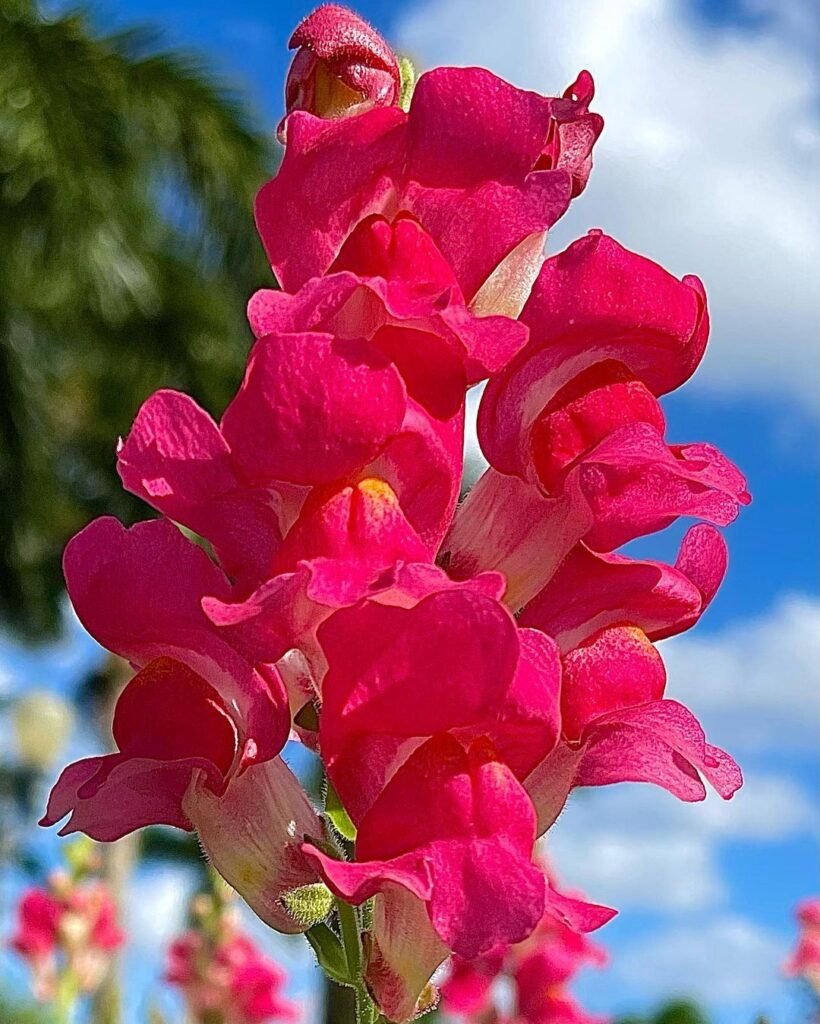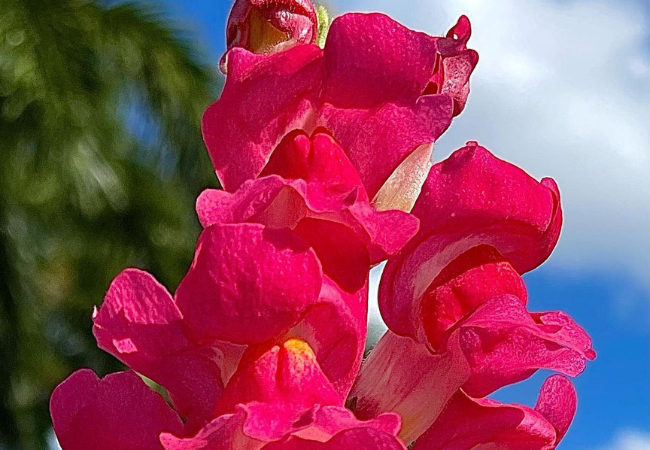Discover expert tips on growing and fertilizing snapdragons (Antirrhinum majus). Learn when to plant, snapdragon colors, and how to keep them blooming!
Hi there! I’m Ashley Scott, and after 10 years of digging in the dirt and coaxing plants to bloom, I’ve fallen head over heels for snapdragons—or as botanists call them, Antirrhinum majus. These colorful beauties, with their playful tubular flowers, have brightened my garden beds and bouquets more times than I can count. Whether you know them as snapdragons, Antirrhinum flowers, or simply “those skull-shaped blooms,” they’re a must-have for any garden enthusiast in the USA. Today, I’m sharing everything I’ve learned about growing and fertilizing snapdragons to keep them thriving, answering your top questions along the way—like when to plant snapdragons, how to keep them blooming, and what those snapdragon colors mean. Let’s get started!
Here’s an easy and verified chart for Snapdragons:
| Category | Details |
|---|---|
| Botanical Name | Antirrhinum majus |
| Common Name | Snapdragon |
| Plant Type | Annual or tender perennial |
| Hardiness Zone | Zones 7-10 (typically grown as an annual) |
| Sun Exposure | Full sun to part shade |
| Soil Type | Rich, well-draining soil |
| Watering Needs | Regular; keep soil evenly moist |
| Growth Habit | Upright, bushy |
| Height/Spread | 6 inches to 3 feet tall, spread of 6-18 inches |
| Special Features | Spiky flower spikes in various colors (pink, red, yellow, white); attracts pollinators; deer resistant; good for cutting and borders |
What Are Snapdragons (Antirrhinum Flowers)?

Snapdragons, or Antirrhinum majus, are charming flowering plants native to the Mediterranean. Their common name comes from the way the flowers snap shut when you pinch them—something I loved showing off to my niece when she was little! Part of the Plantaginaceae family, they’re known scientifically as Antirrhinum, a term derived from Greek meaning “like a nose,” thanks to their snout-shaped blooms.
In the USA, snapdragons are adored for their vibrant colors—think pink, purple, white, yellow, and red—and their ability to bloom from spring through fall with the right care. They grow anywhere from 6 inches to 3 feet tall, depending on the variety, making them perfect for flower beds, borders, or even a snapdragon bouquet. Fun fact: when the flowers dry out, they look like tiny skulls—earning them the nickname “snapdragon skull flower” in folklore!
Curious about more flower origins? Check out my post on Native Flowering Plants over at USA Garden Hub for a deeper dive.
Why Fertilizing Snapdragons Matters
Here’s a question I hear a lot: “Do snapdragons need fertilizer to bloom?” From my experience, yes—fertilizing is key to unlocking their full potential. Snapdragons are moderate feeders, meaning they don’t need a ton of nutrients, but the right fertilizing schedule keeps them blooming longer and stronger. I’ve seen my own snapdragons go from a few measly flowers to a riot of color just by tweaking their food supply. Let’s break it down.
Featured Snippet Answer: How Do You Fertilize Snapdragons?
To fertilize snapdragons, use a balanced liquid fertilizer (like 10-10-10) every 4-6 weeks during the growing season. Apply it in the morning, water it in well, and avoid getting it on the leaves to prevent burn.
When and How to Plant Snapdragons
Another common question: “When do snapdragons flower in the USA?” Snapdragons are cool-season annuals (or short-lived perennials in zones 7-11), so timing is everything. I plant mine in early spring, about 6-8 weeks before the last frost—usually late February or March here in my Zone 6 garden. If you’re starting from snapdragon seeds, sow them indoors 8-10 weeks before transplanting.
Planting Tips
- Soil: They love well-drained, slightly acidic soil (pH 6.2-7.0).
- Sun: Full sun is best, though they tolerate partial shade.
- Spacing: Give them 6-12 inches apart to avoid crowding.
For more on seed-starting, I wrote a handy guide at Growing Flowers from Seeds on USA Garden Hub.
Fertilizing Snapdragons: My Step-by-Step Guide
Fertilizing snapdragons isn’t rocket science, but it’s where I see a lot of gardeners stumble. Here’s how I do it:
1. Start with Healthy Soil
Before planting, I mix in some compost—it’s like giving snapdragons a nutrient-packed welcome mat. The University of Minnesota Extension agrees that organic matter boosts soil fertility naturally.
2. Pick the Right Fertilizer
I swear by a balanced 10-10-10 or 5-10-10 liquid fertilizer—equal parts nitrogen, phosphorus, and potassium (or a little extra phosphorus for blooms). Granular slow-release options work too if you’re forgetful like me sometimes!
3. Timing Is Everything
- At Planting: Add a light dose of fertilizer to the soil.
- During Growth: Feed every 4-6 weeks from spring to late summer. I stop in fall when blooming slows.
- Pro Tip: Water first, then fertilize—it helps the roots soak up nutrients without stress.
4. Avoid Overfeeding
Last summer, I got overzealous with fertilizer, and my snapdragons grew tons of leaves but skimped on flowers. Too much nitrogen is the culprit—it’s a lesson I won’t forget!
For more fertilizing tricks, the Clemson University Cooperative Extension has a great rundown.
How to Keep Snapdragons Blooming
“How do I keep snapdragons blooming all season?” This is a big one! With proper care, mine flower from May to October. Here’s my secret sauce:
- Deadheading: Snip off spent blooms to encourage new ones. I use scissors to avoid damaging the stems.
- Watering: Keep soil moist but not soggy—about an inch per week.
- Fertilizing: That 4-6 week feeding schedule keeps them energized.
The Missouri Botanical Garden confirms deadheading extends bloom time—science backs me up!
Snapdragon Colors and Their Meanings
Snapdragons come in a rainbow of hues, and each color carries a message in the flower language. Here’s what I’ve learned:
- Pink: Grace and charm—perfect for gifting a friend.
- White: Purity and peace—I used these in my sister’s wedding bouquet!
- Red: Passion and strength.
- Yellow: Cheerfulness and positivity.
Fun fact: In snapdragons, flower color is controlled by incomplete dominance, so you might see blends like peach or coral in hybrids. The University of Wisconsin-Madison explains this genetics quirk beautifully.
Common Questions About Snapdragons
Do Snapdragons Flower Every Year?
In most U.S. climates, they’re grown as annuals, but in milder zones (7-11), they can return as perennials. Mine didn’t survive a harsh winter, though!
How Long Do Snapdragons Flower For?
With good care, they bloom 3-5 months. Fertilizing and deadheading stretch it out.
When Do Snapdragons Flower in Australia or the UK?
In Australia, they peak in spring (September-November); in the UK, it’s summer (June-August). Adjust fertilizing to their seasons!
Snapdragon Origins and Fun Facts
Snapdragons hail from rocky Mediterranean hillsides, introduced to the Americas by early settlers. Their name ties to an old superstition—snap a flower, and it wards off deceit! I love their dried “skull” look too; it’s a quirky Halloween decor trick I’ve tried.
For more flower history, the Cornell University Gardening Resources has fascinating insights.
Designing with Snapdragons
I’ve used snapdragons in flower beds, as cut flowers, and even in pots. Pair them with marigolds or zinnias for a pop of color. Want ideas? See my Flower Bed Design Tips at USA Garden Hub.
Where to Find Snapdragons
Looking for snapdragons flowers near me? Check local nurseries or order Antirrhinum flower seeds online. They’re widely available across the USA.
Final Thoughts
Snapdragons—or Antirrhinum flowers—have been a joy in my garden for a decade. With the right fertilizing routine, they’ll reward you with months of stunning blooms. Whether you’re planting snapdragon seeds, crafting a snapdragon bouquet, or just admiring their colors, these flowers bring magic to any space. So grab some fertilizer, get planting, and let me know how it goes—I’d love to hear your stories!
Happy gardening!
Ashley Scott, USA Garden Hub

